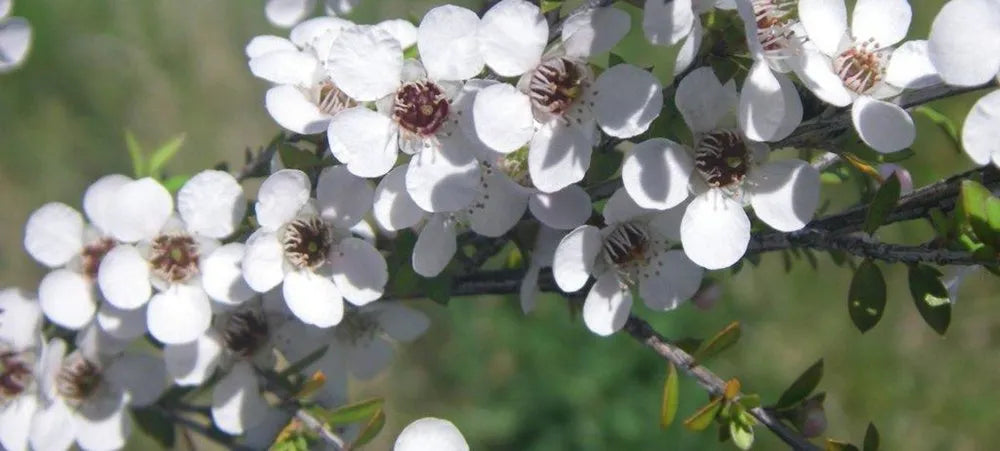
7 Different Types of Acne, Explained
Close your eyes and imagine someone with acne. What do you see? Little white bumps? Wide black pores? An eruption of angry red skin?
Turns out, acne can include all of these things — and more.
Acne isn’t a one-size-fits-all diagnosis. It’s what we call a “multifactorial disease,” which means that it can be caused by many factors. These different triggers can then manifest in a wide variety of blemishes. This is why your breakout may look very different from your best friend’s, your sibling’s, or your significant other’s.
Luckily, Averr Aglow skincare is designed specifically with sensitive skin in mind. With products like our Luminous Clear Skin Kit, you can conquer everything from whiteheads to cysts. No matter what kind of acne you’re facing, Averr Aglow has a skincare solution for you.
Step one on this clear skin journey? Identify your unique adversary. Come along as we explore the 7 most common acne types and find out what’s plaguing your complexion!
1. Whiteheads
Also known as “closed comedones,” whiteheads are one of the most typical forms of acne. They appear on the skin as small or medium bumps, usually whitish or skin-tone in color.
Whiteheads occur when a pore becomes clogged with a mix of dead skin cells and sebum. This clogged pore gets covered by a layer of skin and develops pus within. This pus is what gives the whitehead its white appearance (and name).
Unlike pustules (see below) and most other acne breakouts, whiteheads are considered noninflammatory blemishes. So you’re unlikely to experience swelling and redness with these pimples.

It might be tempting to pop these juicy pimples, but we don’t recommend it. Picking at pus-filled whiteheads will only spread gunk and bacteria to other pores.
Instead, try including ingredients like witch hazel in your acne-free skincare routine. Witch hazel is an effective natural astringent that can help dry up whiteheads and other types of acne. However, it can be a little too astringent for some sensitive skin, so proceed with caution.
Our recommendation? Instead of applying witch hazel directly and risking irritation, get the best of its benefits in a nourishing, skin-safe formulation like our Clear Skin Elixir. The Elixir balances clarifying witch hazel with calming and detoxifying ingredients like French pink clay, removing impurities without putting extra stress on your delicate complexion.
2. Blackheads
Also called “open comedones,” blackheads get their name because they appear as dark spots on your skin.
Like whiteheads, blackheads are caused by clogged pores. Unlike whiteheads, those clogs of oil and skin cells are open to the air. The clogs change color when they come into contact with oxygen, which gives them a dark appearance.
Contrary to popular belief, blackheads have nothing to do with hygiene. If you have blackheads, please remember: you are not dirty! That black stuff is just natural oil and skin.
And since blackheads are essentially just super-blocked pores without any swelling or infection, they are considered noninflammatory. In other words, they won’t be red and painful like some other acne blemishes.

Getting a professional extraction is one way to deal with blackheads, and can be a fantastic way to kick off your cleansing journey. Ultimately, facials are a temporary fix.
For long-term results, stop treating symptoms and start addressing your blemishes at their roots! Keep your pores clear with a balance of cleansing and exfoliation. We know just the thing: Averr Aglow’s Radiant Cleansing Nectar.
Applied with cotton rounds, the Nectar is designed to cleanse deeply and provide gentle daily exfoliation. It includes natural ingredients like hawthorn berry and jojoba oil to remove excess oil, skin cells, and other impurities. So give your face a fresh start and kick those blackheads to the curb!
Hot tip: It’s easy to confuse blackheads with natural skin phenomena called sebaceous filaments. Learn how to tell the difference!
3. Papules
Acne papules are the swollen red bumps that so many of us imagine as “typical” breakouts.
Like other acne blemishes, papules develop when excess oil and dead skin cells clog your pores. Pressure builds up in the blocked pore and can cause the walls of your pore to rupture, spreading nastiness into the surrounding skin. Your immune system responds to the rupture with inflammation, giving papules their red and swollen appearance.

After a few days, most papules graduate to even more noticeable blemishes called pustules. (See below!)
To reduce papules and help prevent the development of pustules, calming inflammation is crucial. Seek out anti-inflammatory botanicals like cucumber, rosewater, and camellia.
To get the best of these ingredients, our go-to combo is a dab of our Flawless Nourishment Cream and a refreshing spritz of our Clarifying Hydration Dew. The Cream deeply moisturizes, helping balance your skin’s oil production to prevent blocked pores. Meanwhile, the Dew gently soothes sore blemishes and helps relieve inflammation.
4. Pustules
Pustules are essentially papules that fill with pus when your immune system kicks in. The red bumps develop a swollen white or yellow cap, giving pustules that classic pimple look.
Not sure if it’s a pustule or a whitehead? Pustules are ringed with redness and swelling, thanks to inflammation. Whiteheads are non-inflammatory blemishes, so they should be less red and painful.
Pustules can form anywhere on your body, but they’re most commonly found in areas such as your face, chest, and back.

As with papules, one of the best ways to prevent pustules is by balancing your skin’s sebum production. While a certain amount of sebum (aka, your natural skin oil) is necessary and healthy, too much can lead to clogged pores and breakouts, including pustules.
But balancing sebum production does not mean skipping moisturizer. Skipping moisturizer can dry out your skin, causing your pores to overcompensate with even more oil. So be sure that your routine includes plenty of skin-friendly hydration!
Trying to get your oil under control? Our Flawless Nourishment Cream is specially formulated for acne-prone skin, to give your complexion the rich, clear-skin moisture that it needs!5. Nodules
Nodules are a more severe form of acne that can be hard to address. They appear similar to papules but start deeper within the layers of your skin, where they are challenging to treat and nearly impossible to pop.
Nodules look like red or skin-colored bumps and never have a “head” like whiteheads or pustules. They feel firm and are painful to the touch.
Acne nodules can appear on their own or in sore patches across your skin. Sometimes they even coexist with equally painful cysts (see below) in a breakout known as nodulocystic acne.

As we said before, nodules are embedded deep in your skin and are tough to treat. In an ideal world, the best way to deal with nodular acne is to prevent breakouts before they start. Priority number one: keeping up a consistent skincare routine.
Easier said than done, right? Life is busy, and you’ve got lots of other stuff to worry about.
It can be easy. Start with a simple skincare regimen already designed to work together, like our Clear Skin Kit. It contains four essential products, which can be used in a matter of minutes. Busy or not, you have time for this!
The kit employs 40+ natural ingredients to cleanse, moisturize, and mildly exfoliate your skin. It addresses the root of your breakouts by helping to balance your oil production, keep your pores clear, and fight harmful, acne-causing bacteria.
Already have a nodular breakout?
If your nodules are feeling sore, you can find some relief by applying a cold compress. Wrap an ice cube in a paper towel or a clean washcloth and apply it to the nodule for 10 minutes. The cold will help reduce inflammation and ease pressure on your nerves.
But whatever you do, do not try to pop nodules! Doing so will only increase your inflammation and cause scarring.
6. Cysts
Cystic acne is another form of severe acne that forms far below the surface of your skin. Like nodules, cysts resemble deep, red lumps. But unlike nodules, cysts are filled with pus or other liquids and feel soft to the touch. Either way, they can be very tender and painful.
Cystic acne is common along the face and jawline, or even as bacne. Caused by the usual trifecta of excess oil, dead skin, and bacteria, cysts are a particularly stubborn form of a breakout, lingering for weeks or even months.
Cue the desperation!

Since cysts feel so soft, trying and draining them can be extra tempting. DON’T!
Of all acne blemishes, cysts are the most likely to leave a scar, and trying to pop them will only make the scarring worse. Plus, picking at cysts can spread the infection. Translation: Picking can make cysts bigger.
Cystic acne is not caused by poor hygiene. However, following a nourishing skincare routine designed for acne-prone skin can help to keep cystic acne under control and prevent future breakouts.
Cystic acne forms deep within your skin, where most treatments don’t reach. But our Clear Skin Elixir is worn overnight, so the healing powers of camellia and French pink clay have time to sink in and repair your skin from within!7. Milia
We’ll be honest: milia (sometimes known as “milia seeds”) aren’t technically classified as acne. But they’re often confused for pimples and should be on your radar if you’re trying to identify mystery blemishes.
Technically tiny cysts, milia are small, light bumps that often crop up around your nose, cheeks, and eyes. They are caused by trapped skin flakes or keratin deposits. Keratin is the protein responsible for keeping your hair, skin, and nails strong. But when it gets caught beneath your skin, it causes hard bumps to form.

Milia usually disappears on their own after a few months. To speed the process along, there are a few steps you can take:
Cleanse daily with mild, skin-friendly soap. (What’s that? Did someone mention our Radiant Cleansing Nectar?)
Try facial steaming to dilate your pores. If you don’t have a fancy facial steamer, no worries! The steam from a hot shower can do the trick.
Avoid picking at Milia. The keratin deposit must work its way up through your skin, and trying to extract it sooner can lead to irritation and scarring.
Incorporate exfoliation into your routine. We recommend adding exfoliating 2-3 times a week with a gentle scrub like our Illuminating Essence Exfoliating Mask. It buffs your complexion with volcanic ash and silica for a smooth, refreshed glow. (Bonus: exfoliation can also help prevent new milia from forming.)
Acne can plague you in many ways, and sometimes you may even struggle with several types simultaneously. But there is hope on the horizon!
See how Averr Aglow has helped people from all walks of life and with all kinds of blemishes. From stubborn pimples to extreme cystic acne, our products can help you finally achieve the clear and vibrant skin you deserve!
What to Do Next? Try Averr Aglow’s Clear Skin Kit
Tired of feeling lost and confused about what you should do to get clear, smooth skin? Order the Clear Skin Kit.
The Clear Skin Kit contains products specially crafted with the perfect blend of natural ingredients that help soothe and calm red, irritated skin while also clearing up breakouts. If you struggle with sensitive acne/breakout-prone skin, hormonal acne, cystic acne, or rosacea, then you’ll be happy you found this complete routine.
Please understand, that results may vary, we’re not selling you a miracle product and would never try to position or state that you will get a true result in only a few days. In our clinical trials, most users found the most results at the 30-day and then the 56-day mark by sticking with our routine.
What is Averr Aglow®?
Averr means Truth. We have pioneered a revolutionary no-rinse cleansing routine specifically tailored to address problematic skin issues.
Hi, I’m Camille, founder of Averr Aglow, and I help adult women who are battling breakouts and acne get clear skin results like they have never seen before, even if nothing has worked for them in the past.
After battling breakouts for over 16 years, trying every skincare product under the sun, and visiting countless professionals like dermatologists, nutritionists, and hormonal doctors, I finally learned why nothing seemed to work on clearing up my skin, what truly causes breakouts and acne, and EXACTLY what to do to get clear skin results – and I want to help you do the same.
Let me help you! Read my full testimonial here.






